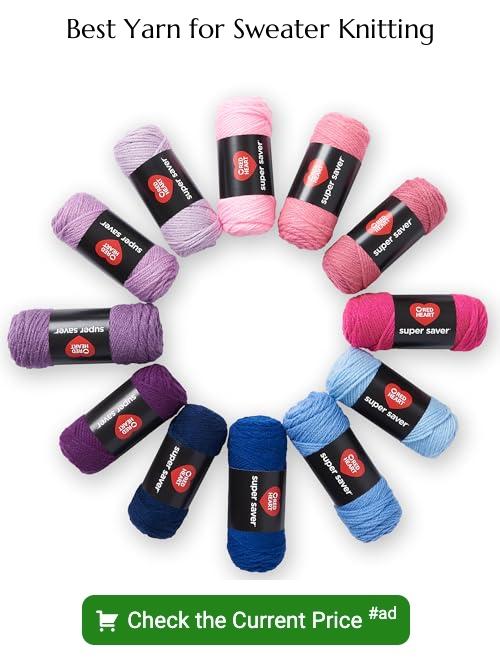Discover the perfect yarn for your next sweater project as we explore various types of yarn and their unique qualities in this informative guide.
Are you ready to start knitting a cozy sweater for the upcoming chilly weather? One of the most important decisions you’ll make is choosing the right type of yarn. With so many different options available, it can be overwhelming to know where to start.
But fear not! In this article, we’ll explore some of the best types of yarn for sweaters and what makes them ideal for this particular project. From soft and fluffy alpaca wool to durable and versatile cotton blends, we’ve got you covered.
So grab your needles and let’s get started!
What Kind of Sweater You Would Like to Make
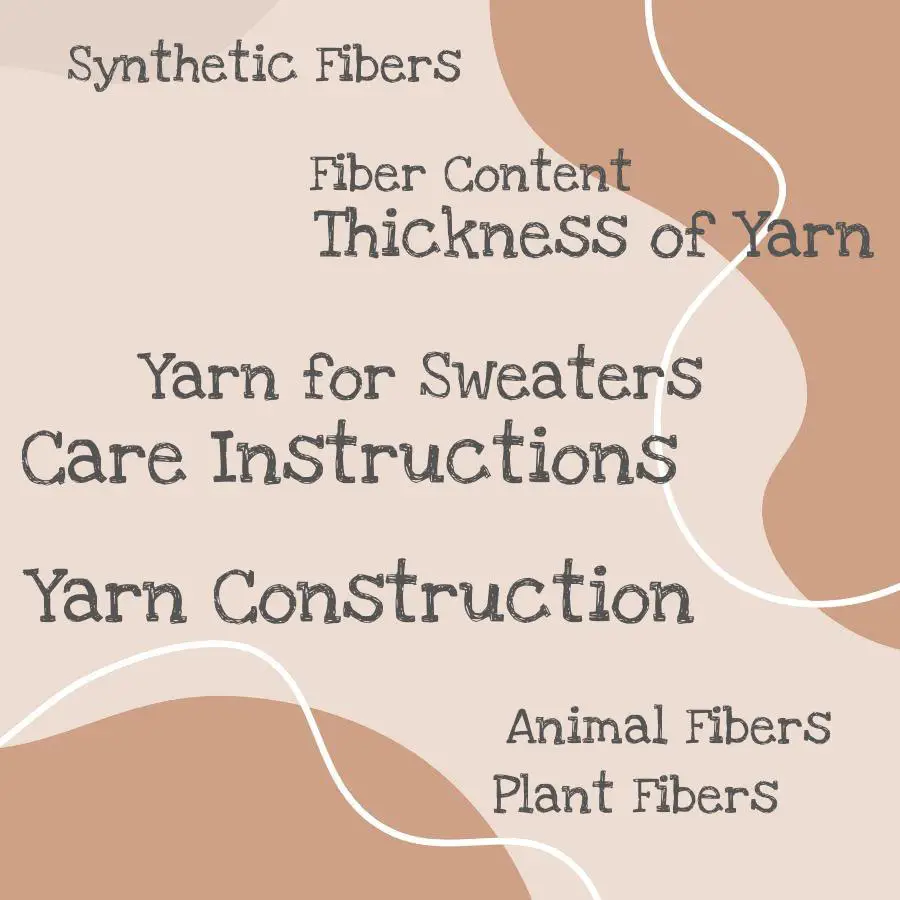
Before you start shopping for yarn, it’s important to consider what kind of sweater you would like to make. Are you looking for a lightweight cardigan or a chunky pullover? Do you want something fitted or oversized? The style and fit of your sweater will play a significant role in determining the type of yarn that is best suited for your project.
For example, if you’re making an oversized sweater with lots of drape, then choosing a bulky weight yarn made from alpaca wool might be ideal. On the other hand, if you’re knitting a fitted cardigan that needs structure and stitch definition, then using cotton or linen blends may be more appropriate.
Consider also where and when this garment will be worn. If it’s intended as outerwear during colder months – choose warm fibers such as wool; however if it’s meant to wear indoors on warmer days – opt-in lighter materials such as cotton blends.
Fiber Content
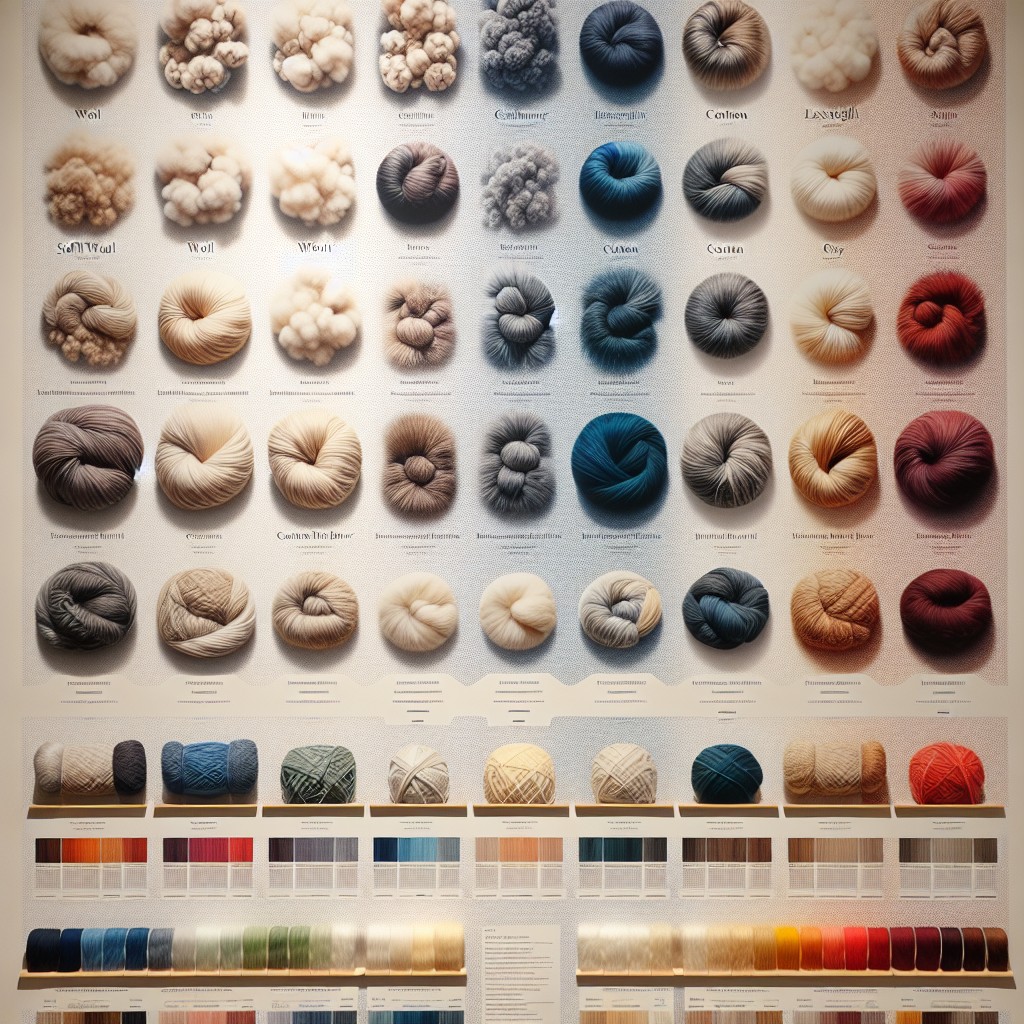
Different fibers have unique qualities that can affect how your finished garment looks and feels. Some popular animal fibers used in sweaters include wool, alpaca, cashmere, and mohair.
These natural fibers are known for their warmth and softness but may require special care when washing.
Plant-based fibers like cotton or linen are also great options for sweaters as they tend to be more breathable than animal-based ones. Synthetic materials such as acrylic or nylon offer durability at a lower cost point but may not provide the same level of warmth as natural alternatives.
Blends combining different types of fiber can offer a balance between these characteristics while providing additional benefits such as increased elasticity or reduced pilling.
1 Animal Fibers
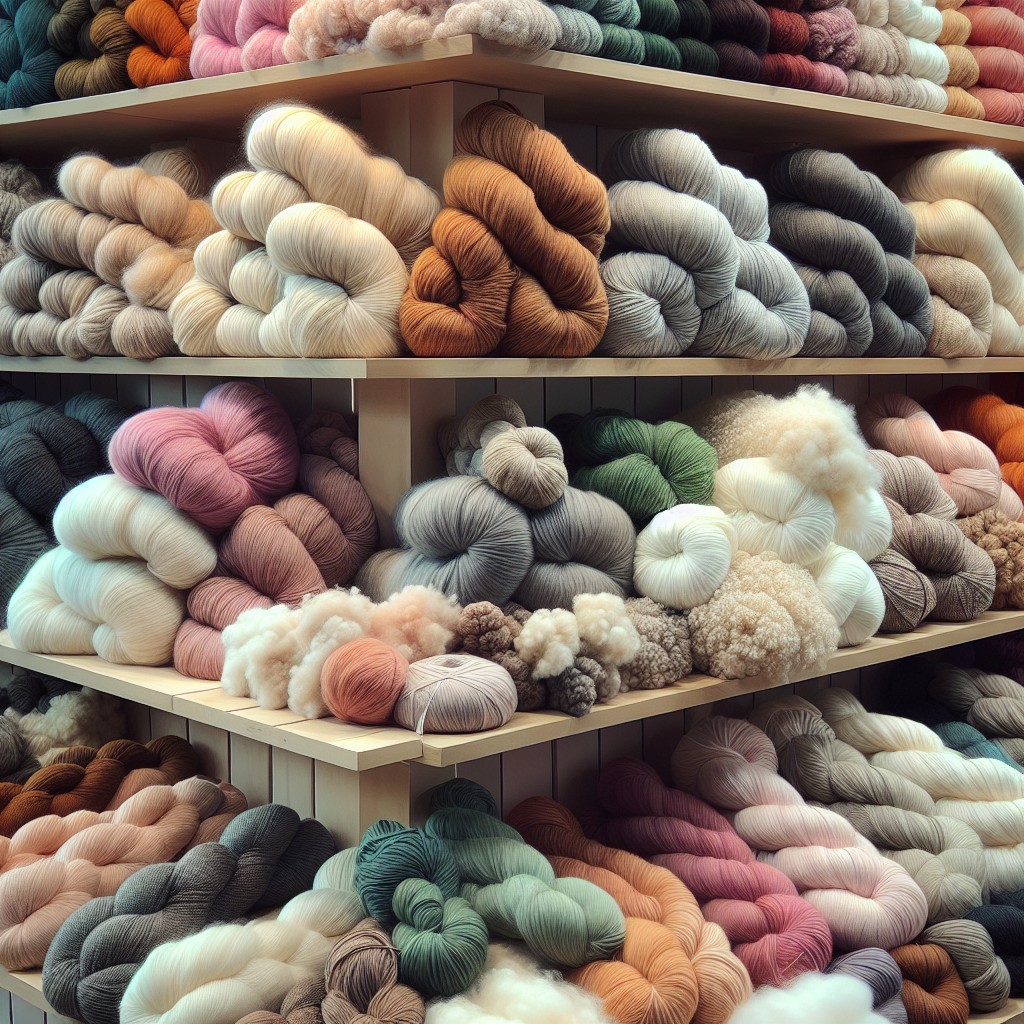
Wool is the most common animal fiber used in knitting and crocheting. It comes from sheep but can also be sourced from other animals such as alpacas, llamas, goats (cashmere), rabbits (angora), or even camels.
Wool is available in different weights ranging from lace weight to super bulky. The thickness of wool yarn depends on the breed of sheep it came from and how it was spun.
Merino wool is one of the most popular types of wool for sweaters because it’s incredibly soft and comfortable against your skin while still being warm enough to keep you cozy during colder months.
Alpaca fiber has gained popularity over recent years due to its luxurious feel that’s softer than cashmere yet warmer than traditional wool. Alpaca yarns come in various weights with natural colors ranging between white through black with many shades between them.
2 Plant Fibers
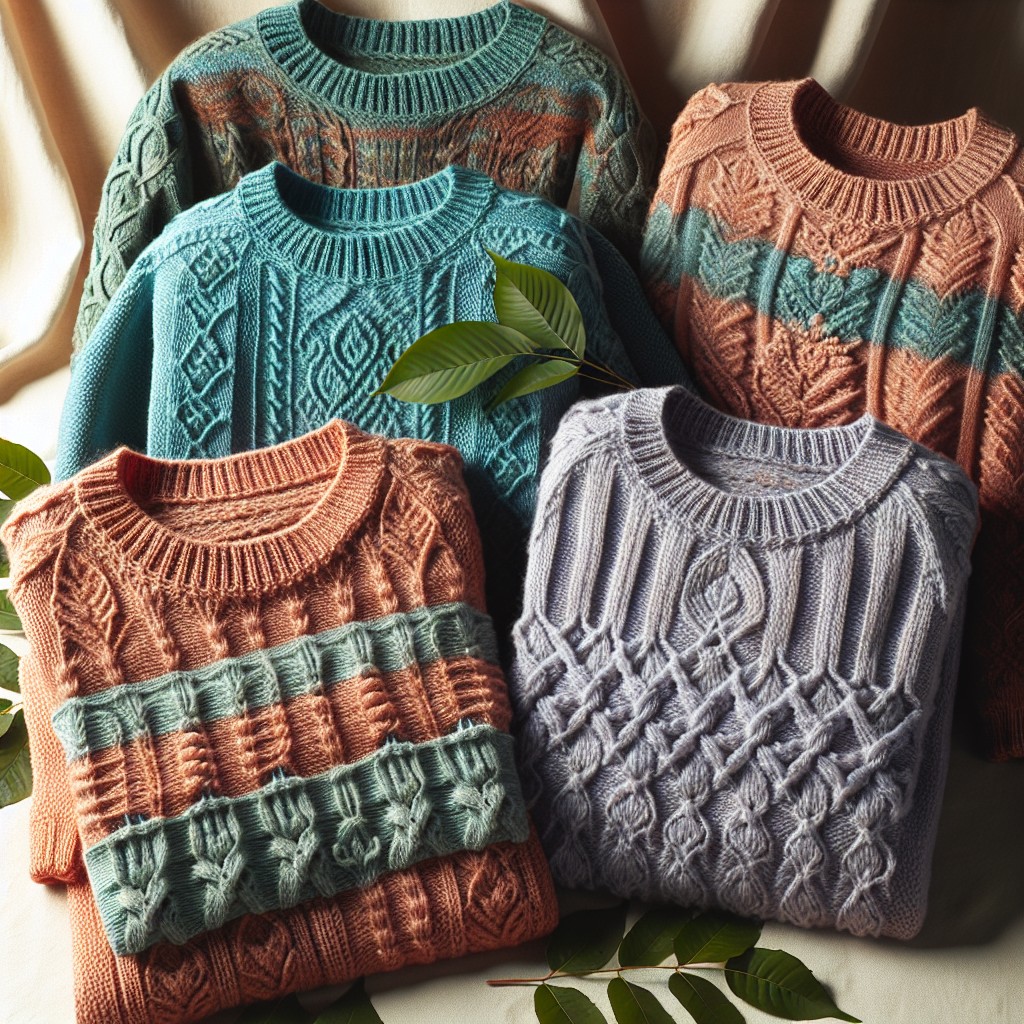
They’re also great for people with sensitive skin, as they tend to be hypoallergenic and breathable.
Cotton is one of the most common plant fibers used in knitting and crocheting. It’s soft, durable, and easy to care for – making it perfect for everyday wear sweaters that will get a lot of use.
Linen is another plant fiber that’s ideal for summer sweaters due to its lightweight nature and breathability. It has a unique texture that adds interest to any garment but can be difficult to work with due to its tendency towards stiffness.
Other plant-based yarns include bamboo (which has antibacterial properties), hemp (which gets softer with each wash), soy silk (made from leftover soybean pulp), and Tencel (a sustainable wood pulp-based fiber).
3 Synthetic Fibers
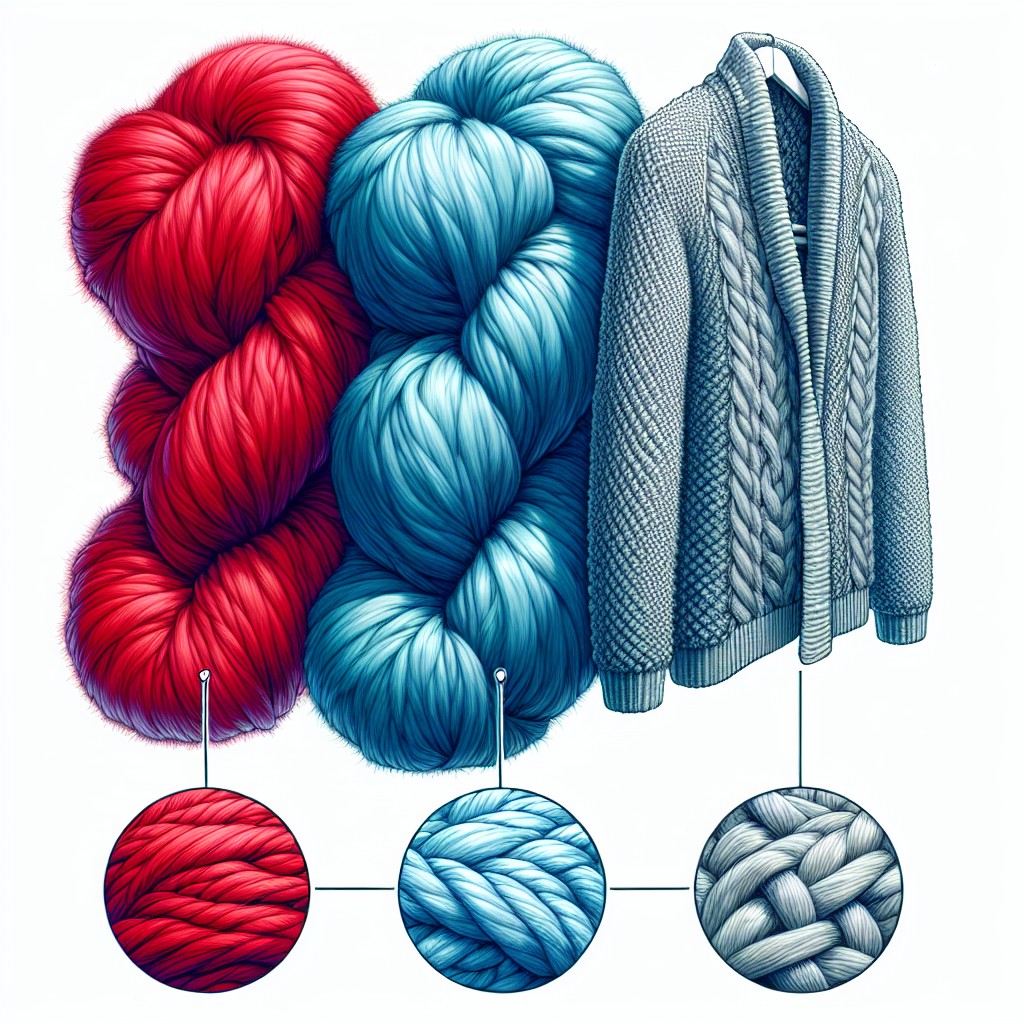
Acrylic is one of the most popular choices because it’s affordable and easy to care for. It’s also lightweight and soft, making it perfect for cozy sweaters that you can wear all day long.
Another great option is nylon, which adds durability and strength to your sweater without adding too much weight or bulk. This makes it ideal if you’re looking to create a sweater that will last through multiple seasons.
Polyester is another synthetic fiber commonly used in yarns. It has excellent moisture-wicking properties which make polyester blends an excellent choice if you live in a humid climate or plan on wearing your sweater during physical activities like hiking or running.
4 Blends
Blends are made by combining two or more different fibers together, creating a unique combination that offers the best of both worlds. For example, wool and silk blends provide warmth and softness while also adding a luxurious sheen to your finished garment.
Cotton and acrylic blends are another popular choice for sweaters as they offer durability, breathability, and easy care all in one package. These types of yarns tend to be less expensive than pure cotton or wool options but still provide excellent results.
If you’re looking for something extra special in terms of texture or color variation then consider trying out some novelty blend yarns which incorporate fun elements like sequins or metallic threads into their construction.
Care Instructions
Different types of yarn require different care instructions, so be sure to read the label carefully before washing or drying your finished garment. Some fibers may need special attention, such as hand-washing or laying flat to dry instead of using a dryer.
It’s also essential to think about how often you’ll wear and wash your sweater when selecting a type of yarn. If you plan on wearing it frequently and washing it often, choose a durable fiber that can withstand regular use without losing its shape or color.
On the other hand, if this is going to be an occasional-use item that will spend most of its time in storage between wears (like holiday sweaters), then feel free not worry too much about durability but focus more on softness and comfort.
Thickness of Yarn
The thickness of a yarn is often referred to as its weight and can range from super fine (category #1) all the way up to super bulky (category #6).
The weight of your chosen yarn will determine how warm and cozy your finished sweater will be, as well as how quickly you’ll be able to complete it. Thicker yarns tend to work up faster than thinner ones but may not have the same drape or softness.
If you’re looking for a lightweight sweater that’s perfect for layering in transitional seasons like spring or fall, then opt for a DK-weight (#3) or worsted-weight (#4) yarn. These weights are versatile enough that they can also work well in winter with proper layering.
On the other hand, if you want something extra warm and chunky that’s ideal for snuggling up on cold winter nights by the fire, then go with bulky (#5) or super-bulky (#6). Keep in mind though; these thicker weights require more yardage per stitch than their lighter counterparts.
Yarn Construction
Plied yarn is made up of multiple strands twisted together, while single-ply yarn consists of just one strand. Each type has its own unique characteristics that can affect the look and feel of your finished sweater.
Plied yarn tends to be more durable than single-ply because the twisting process helps keep the fibers in place. It also has a smoother appearance with less fuzziness or halo effect around each stitch.
This makes it ideal for intricate stitch patterns where you want each detail to stand out.
Single-ply yarn, on the other hand, is softer and fluffier than plied because there’s no twisting involved which allows for more air between fibers giving a lofty texture that feels cozy against your skin. However, this type of construction can be prone to pilling over time due to its loose structure.
Color
When selecting yarn colors, consider what you’ll be wearing with your sweater and where you’ll be wearing it. If you’re making a classic piece that will go with everything in your wardrobe, neutral shades like black, white or gray are always a safe bet.
However, if you want to add some personality to your garment or make it stand out from the crowd, bold hues like reds and blues can do just that.
Another thing to keep in mind when selecting colors is how they interact with each other. Some shades complement each other beautifully while others clash horribly! A good rule of thumb is to choose two complementary colors (colors opposite on the color wheel) for a harmonious look.
Conclusion
By considering factors such as fiber content, care instructions, thickness of yarn and color options you can make an informed decision that will ensure your finished garment looks and feels amazing. Remember to also consider ease of care, cost and availability when selecting the perfect yarn for your project.
Whether you’re looking for a soft alpaca wool or durable cotton blend – there’s no shortage of options available on the market today. So take some time to explore different types of fibers and weights before making a final decision.
Ease of Care
Some fibers require special attention and can be difficult to maintain, while others are more low-maintenance. If you’re making a sweater that will get a lot of wear or if you simply don’t have the time or energy for fussy care instructions, then opt for yarns that are machine washable and dryable.
Acrylic blends are often an excellent choice because they’re durable and easy-care. They also tend not to shrink in the wash like some natural fibers do.
Cotton is another great option as it’s breathable, lightweight, and can be washed easily at home.
On the other hand, wool requires more careful handling as it tends to felt when exposed to heat or agitation during washing/drying cycles; however many wool blends offer easier maintenance than pure wool options.
Cost
While some high-end luxury fibers may be tempting, they can also come with a hefty price tag. It’s essential to keep in mind that the cost of yarn will vary depending on the fiber content, thickness, and brand.
If you’re working within a budget or looking for more affordable options, there are plenty of excellent choices available that won’t break the bank. Acrylic blends are often less expensive than natural fibers like wool or alpaca but still offer warmth and durability.
On the other hand, if you’re willing to splurge on luxurious materials such as cashmere or silk blends – go ahead! Just make sure it fits within your budget before making any purchases.
Ultimately it comes down to personal preference and what works best for your wallet.
Availability
While some specialty yarns may be harder to find in local stores, they can often be purchased online from various retailers. However, keep in mind that shipping times and costs may vary depending on where you live and where the retailer is located.
If you’re looking for a more accessible option or need your yarn quickly, consider checking out big-box craft stores or local shops that carry a variety of brands and types of yarn. These locations are likely to have popular options like wool blends or acrylic fibers readily available.
It’s also worth noting that certain types of fiber may only be available during specific seasons due to their natural harvesting cycles. For example, cotton tends to be more abundant during warmer months while wool is typically harvested in colder weather.
Best Yarns for Sweaters
One of the most important is the weight or thickness of the yarn. Different weights will create different textures and drape in your finished garment, so it’s essential to choose one that suits your desired style.
For sweaters, some popular categories include DK weight (#3), worsted weight (#4), bulky (#5), and super bulky (#6) yarns. DK weight is perfect for lightweight sweaters with excellent drape, while worsted-weight provides more structure and warmth.
Bulky and super-bulky options are ideal for cozy winter knits like oversized cardigans or chunky pullovers.
Some great brands that offer high-quality sweater-worthy yarns include Malabrigo (known for their soft merino wool blends), Cascade Yarns (offering a wide range of fibers at affordable prices) & Brooklyn Tweed (specializing in breed-specific wools).
1 DK Weight Yarn (Category #3)
It’s lightweight and versatile, making it perfect for both warm and cool weather garments. This type of yarn typically has 11-15 wraps per inch (WPI) and is slightly thicker than sport weight but thinner than worsted weight.
One of the benefits of using DK weight yarn for sweaters is that it creates a beautiful drape when knit up. The fabric created by this type of yarn falls nicely on the body without being too heavy or bulky.
Some great options to consider when choosing DK weight yarn include merino wool blends or alpaca blends which provide warmth without adding bulkiness to your garment. Cotton blends are another excellent option if you’re looking for something lighter in texture that can be worn year-round.
When selecting your DK-weight sweater project’s color palette, keep in mind that darker colors tend to make the garment look heavier while lighter shades create an airy feel – so choose accordingly based on what you want from your finished product!.
2 Worsted Weight Yarn (Category #4)
It’s also widely available, making it an excellent option for those on a budget or who need to purchase large quantities of yarn. This category #4 yarn typically has 16-20 stitches per four inches and can be made from various fibers such as wool, cotton, acrylic or blends.
One of the best things about worsted weight yarn is that it works well for both beginner and experienced knitters alike. Its medium thickness makes it easy to see your stitches while still being thin enough to create intricate patterns if desired.
Some great options in this category include Cascade 220 Superwash Wool Yarn which comes in over 100 colors; Berroco Vintage Worsted Yarn which offers excellent stitch definition; Lion Brand Heartland Yarn which has beautiful heathered shades inspired by national parks across America.
When choosing worsted weight yarns consider the fiber content carefully based on what you want out of your finished garment – do you want something warm? Soft? Durable? Easy-care?.
3 Bulky Yarn (Category #5)
Category #5 bulky yarns are thicker than worsted weight but not as thick as super bulky. Here are three of the best options:
1. Wool-Ease Thick & Quick: This acrylic/wool blend from Lion Brand Yarn is soft, machine washable, and comes in a wide range of colors.
2. Cascade 128 Superwash: Made from 100% merino wool, this superwash treated yarn is easy to care for and has excellent stitch definition.
3. Malabrigo Rasta: If you’re looking for something extra luxurious, try this hand-dyed merino wool from Uruguay’s Malabrigo Yarns.
It’s incredibly soft with beautiful color variations that will make your sweater truly unique.
4 Super Bulky Yarn (Category #6)
This category of yarn (#6) is perfect for those who want to finish their project in no time. Super bulky yarns are thick and fluffy, making them ideal for creating chunky knits with lots of texture.
One popular option in this category is Wool-Ease Thick & Quick by Lion Brand Yarn. It’s made from an acrylic/wool blend that creates a soft yet durable fabric with excellent stitch definition.
Another great choice is Bernat Softee Chunky Yarn which comes in many colors and has been used by many crocheters or knitters worldwide.
When working with super bulky yarns, it’s important to keep your stitches loose so that the finished garment doesn’t become too stiff or rigid. You’ll also need larger needles than usual (around US 13-17) to accommodate the thickness of the fibers.
Novelty Yarn
It comes in various forms, such as boucle, eyelash, ribbon, or ladder yarn. While novelty yarn can be fun to work with and create unique designs for sweaters or other garments, it’s important to keep in mind that it may not be the best choice for every project.
If you’re looking for a more classic look or want your sweater to have clean lines without any added frills or textures – then novelty yarn might not be the right fit. However if you’re feeling adventurous and want something different from traditional wool blends – then give this type of fiber a try!
When working with novelty yarns make sure you choose simple patterns so that the texture of the fibers can shine through without being lost in complicated stitches. Also consider using them sparingly as an accent rather than throughout an entire garment.
Choosing Yarn for Children’s Sweaters
First and foremost, you’ll want to choose a yarn that is soft and gentle on their delicate skin. Look for options made from natural fibers like cotton or wool blends that won’t irritate sensitive skin.
Another important consideration is durability. Children can be tough on their clothes, so you’ll want a yarn that can withstand frequent washing and wear without losing its shape or color.
Think about the colors and patterns your child will love! Bright hues in fun stripes or playful motifs are sure to delight little ones.
Some great options for children’s sweater yarns include washable merino wool blends like Berroco Vintage DK or Cascade 220 Superwash Sport. Cotton blends like Plymouth Yarn Dreambaby DK work well too since they’re easy-care while still being soft against the skin.
Choosing Yarn for Selling Sweaters
Not only do you want a high-quality material that will last, but also one that’s affordable and readily available. When selecting yarn for selling sweaters, consider the following factors:
1. Cost: You’ll need to factor in the cost of materials when pricing your finished product.
2. Durability: Choose a durable fiber that can withstand frequent wear and washing.
3. Availability: Opt for a widely available yarn so customers can easily purchase more if needed.
4. Softness: Many people prefer soft fibers against their skin, so choose something comfortable yet sturdy enough to hold up over time.
5.Color options : Consider using colors with broad appeal or those which are currently on-trend.
Some popular choices for selling sweaters include wool blends like merino wool or alpaca blends as they offer warmth and durability at an affordable price point while still being soft against the skin. Ultimately it comes down to what type of sweater you plan on making – chunky knits may require thicker fibers while lighter weight garments may benefit from finer threads such as cotton or silk blends.
Yarn Weight
Yarn weight refers to how thick or thin a strand of yarn is and can range from super fine (also known as lace) all the way up to super bulky. The weight you choose will depend on several factors, including your pattern’s gauge and stitch count.
If you’re making a sweater for yourself or someone else, it’s essential that you choose a yarn with an appropriate weight. A too-thin yarn may result in holes in your finished garment while using too thick of a thread could make it heavy and uncomfortable.
Most patterns will specify which category of yarn they require based on their thickness; however, if yours doesn’t have this information included, be sure always to check the label before purchasing any skeins. This information should be listed under “yarn category” or “yarn weight.”.
In general terms:
- Lace: used mainly for shawls
- Fingering: perfect choice when knitting socks
- Sport/DK: ideal option when knitting baby clothes
- Worsted/Aran : great choice for sweaters
- Bulky/Chunky : good option if looking forward quick projects
What Is Your Budget?
While some high-end luxury fibers can be tempting, they may not fit within everyone’s budget. However, that doesn’t mean you have to sacrifice quality or style! There are plenty of affordable options available that still offer excellent results.
If you’re on a tight budget, look for yarns made from synthetic materials such as acrylic or nylon blends. These types of yarns are often less expensive than natural fibers and come in a wide range of colors and textures.
Alternatively, if you’re willing to spend a bit more money on your project but don’t want to break the bank entirely, consider wool blends or cotton blends. These types of yarns offer both affordability and durability while still providing excellent stitch definition and texture.
Yarns I Love & Recommend
However, after years of experience in crocheting and knitting, I have found some yarns that stand out from the rest. These are my go-to choices when making sweaters.
For fall and winter projects, I love using wool blends such as Lion Brand Wool-Ease or Patons Classic Wool Worsted. They offer warmth without being too heavy or bulky on the body.
In contrast, for spring and summer projects where breathability is key but you still want a bit of texture to your garment try cotton blends like Berroco Modern Cotton DK or Cascade Ultra Pima Fine which provide excellent stitch definition while keeping things light.
Another favorite is Malabrigo Rios – a superwash merino wool that comes in an array of beautiful colors with great stitch definition making it ideal for any season!.
1 For Fall & Winter
One of my favorite yarns for this season is wool. Wool is a natural fiber that has excellent insulating properties, making it perfect for cold weather garments like sweaters.
It’s also durable and long-lasting, so your sweater will hold up well over time.
Another great option is alpaca wool. Alpaca fibers are incredibly soft and lightweight while still being very warm – even warmer than sheep’s wool! This makes them ideal for creating snuggly sweaters without adding too much bulk or weight.
If you’re looking to add some texture or interest to your sweater project, consider using a tweed yarn. Tweed contains small flecks of different colored fibers woven throughout the main color which creates an interesting visual effect in the finished garment.
2 For Spring & Summer
Two of my favorite yarns for these seasons are cotton and linen.
Cotton is a classic choice for warm-weather garments because it’s soft, comfortable against the skin, and easy to care for. It also has excellent absorbency properties which make it perfect if you’re planning on wearing your sweater during outdoor activities or in humid climates.
Linen is another great option as its natural fibers allow air circulation making it highly breathable. Linen can be stiff at first but becomes softer with each wash while still maintaining its shape well over time.
Both cotton and linen come in a variety of weights from lace weight all the way up to bulky so there’s plenty of options depending on what type of garment you’re looking to create. Some popular blends include cotton-linen blends which offer the best qualities from both materials such as breathability combined with durability.
In conclusion when selecting yarns suitable for spring & summer sweaters choose those that will keep you cool while being durable enough not only through washing but also wear & tear throughout their lifespan!.
FAQ
What type of yarn is best for sweater?
The best type of yarn for a sweater is acrylic, polyester, wool (especially superwash wool) or fiber blends, as they are easy to care for, comfortable, and affordable.
What is the best yarn thickness for sweaters?
The best yarn thickness for sweaters is #5 bulky weight yarn, as it is thicker than #4 medium weight yarn and creates warm sweaters.
Which natural and synthetic yarn materials are most suitable for sweater knitting?
Natural yarn materials like wool, alpaca, and cashmere, and synthetic materials like acrylic and polyester are most suitable for sweater knitting.
How does yarn weight affect the warmth and comfort of a sweater?
Yarn weight impacts the warmth and comfort of a sweater, as heavier yarns generally create warmer, denser garments, while lighter yarns yield more lightweight and breathable pieces.
What factors should be considered when choosing yarn for a specific sweater pattern?
Answer: When choosing yarn for a specific sweater pattern, consider factors such as yarn weight, fiber content, drape, texture, and color.
